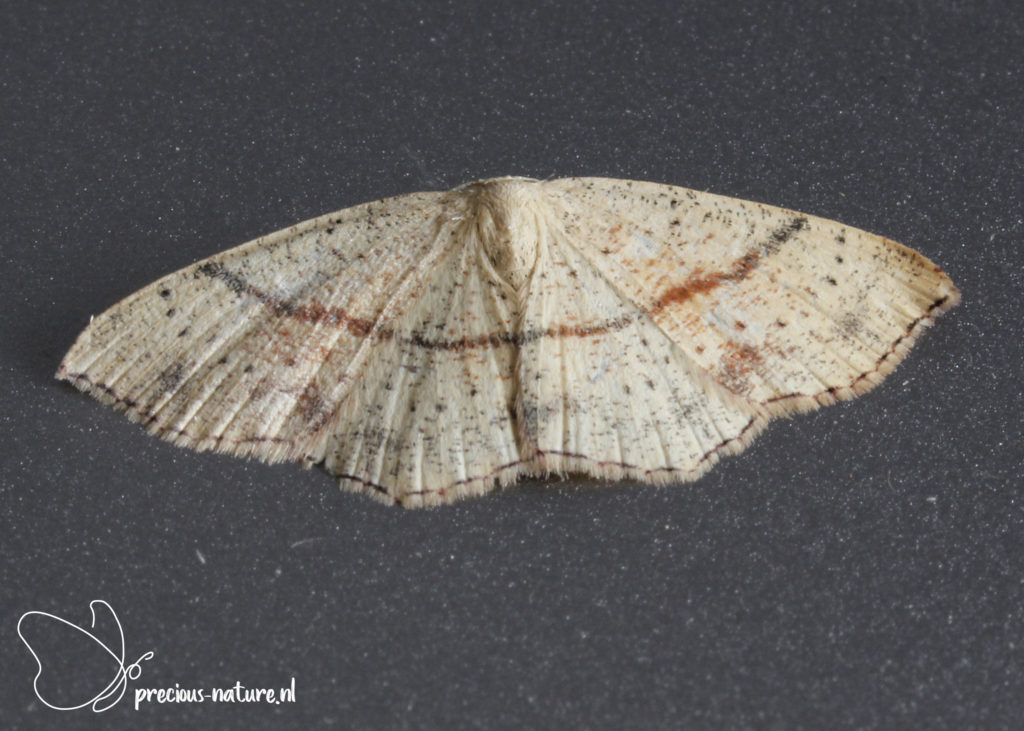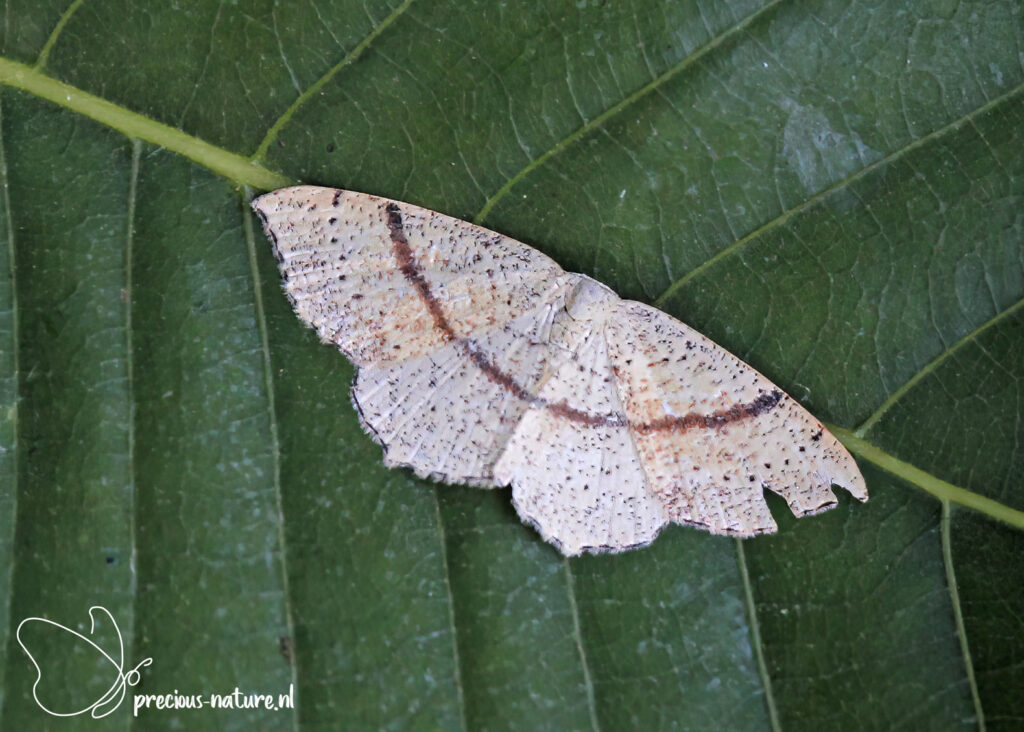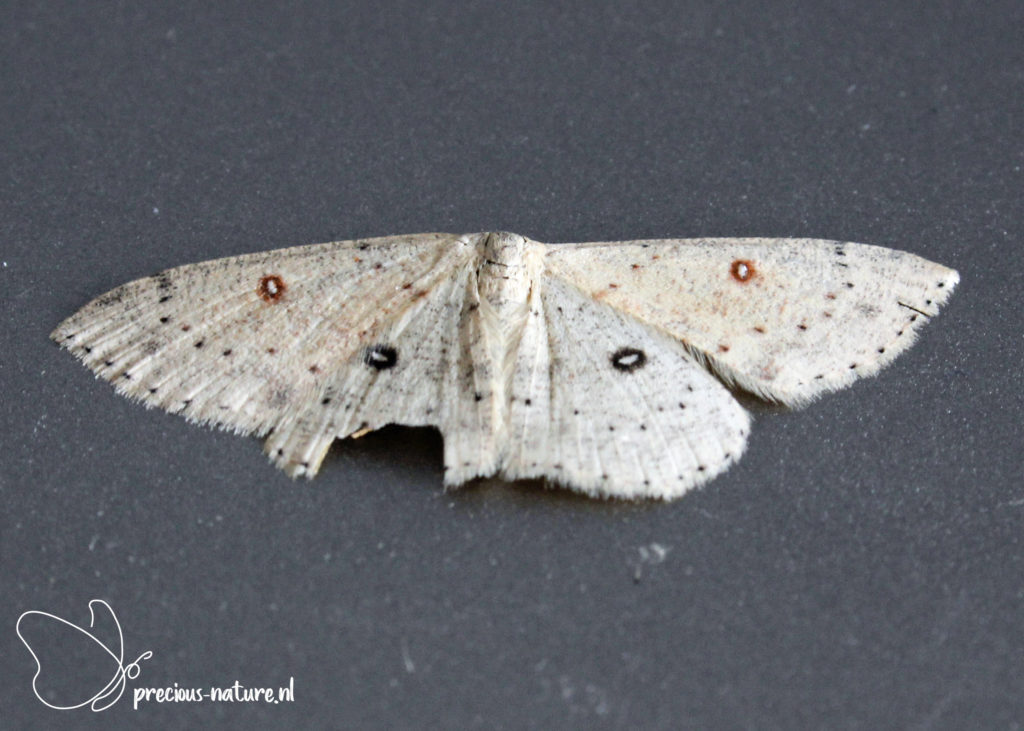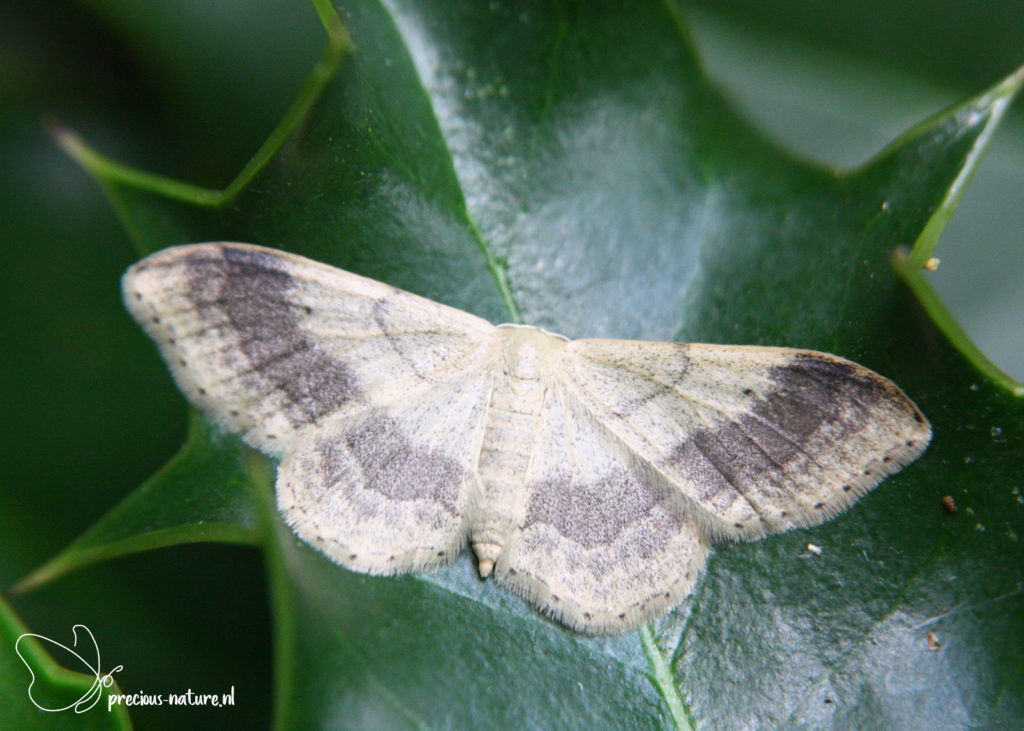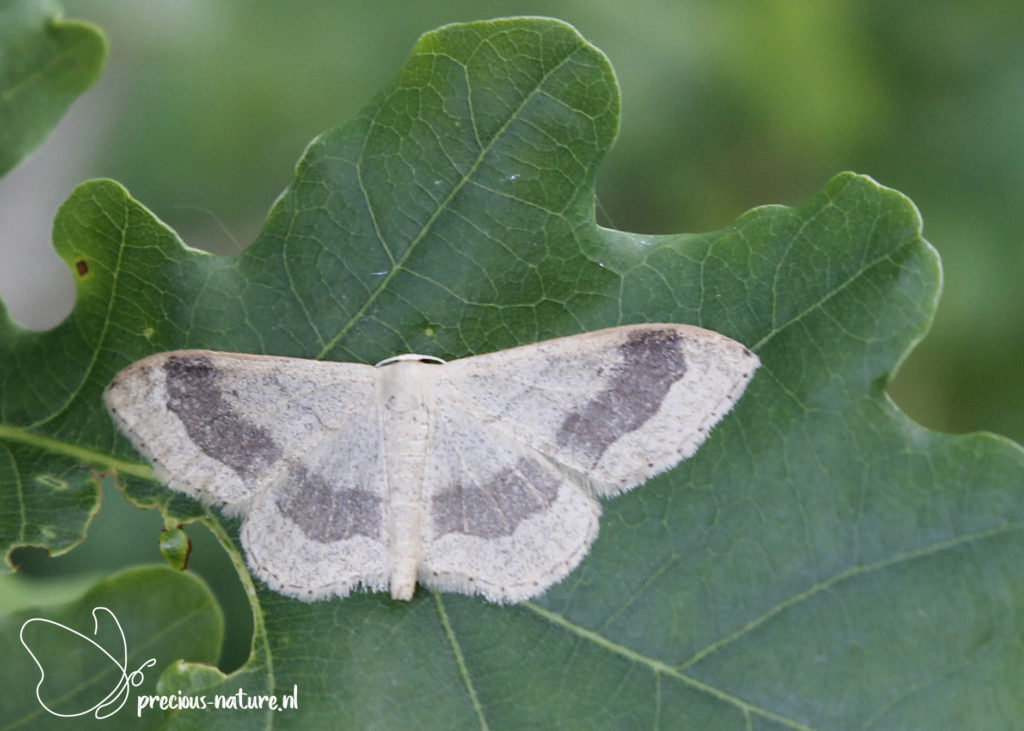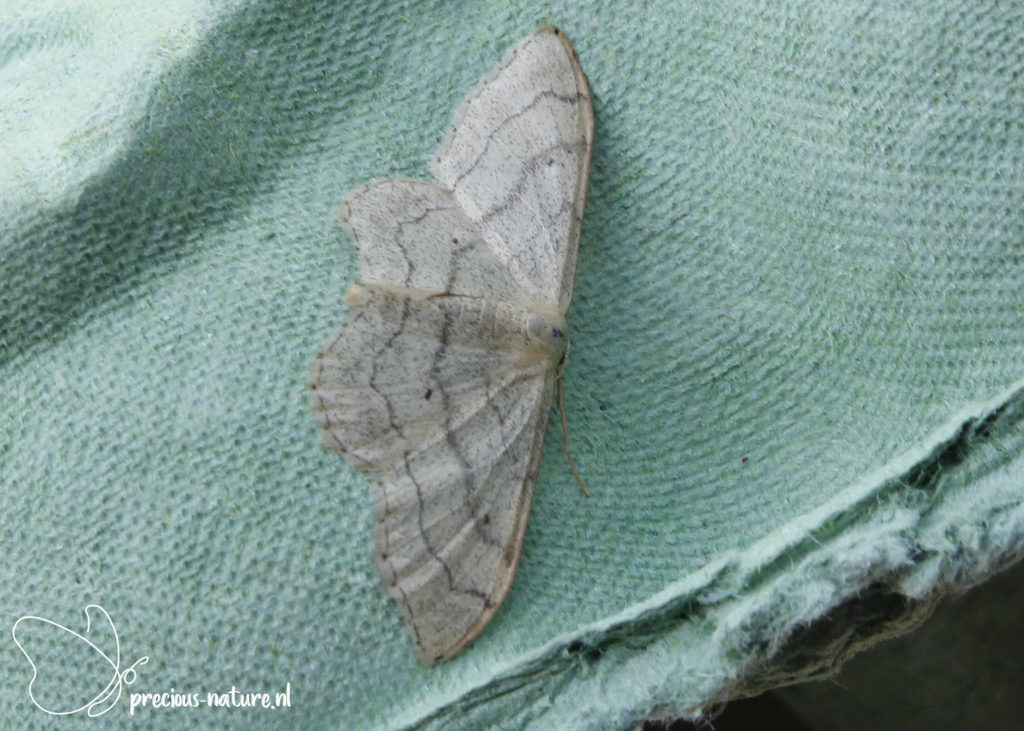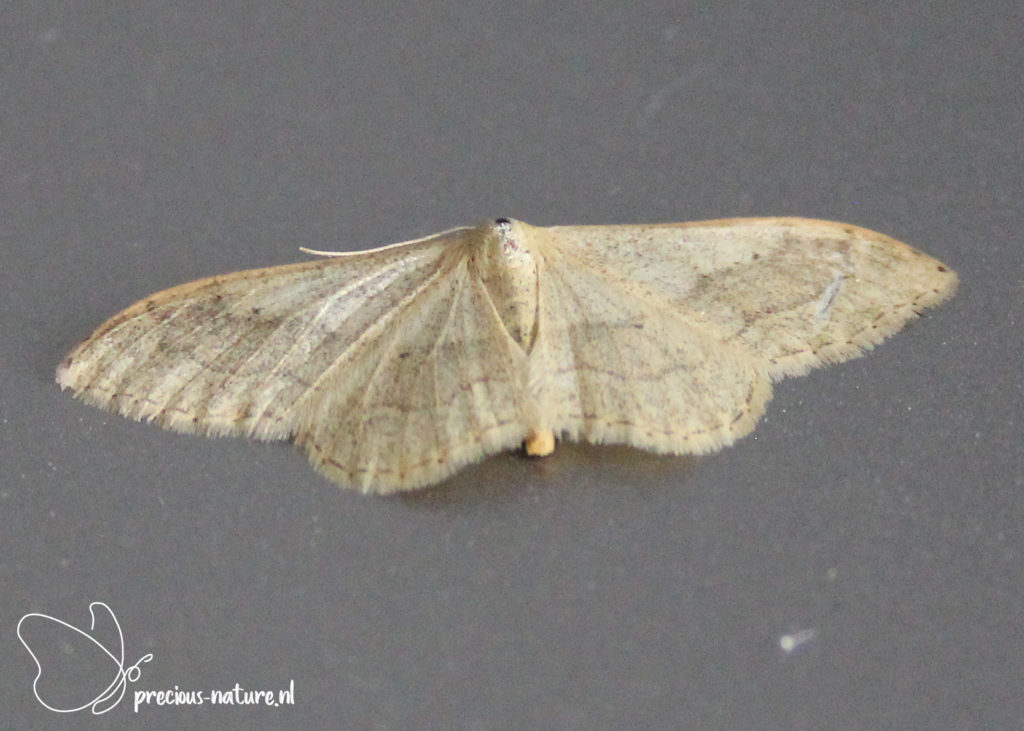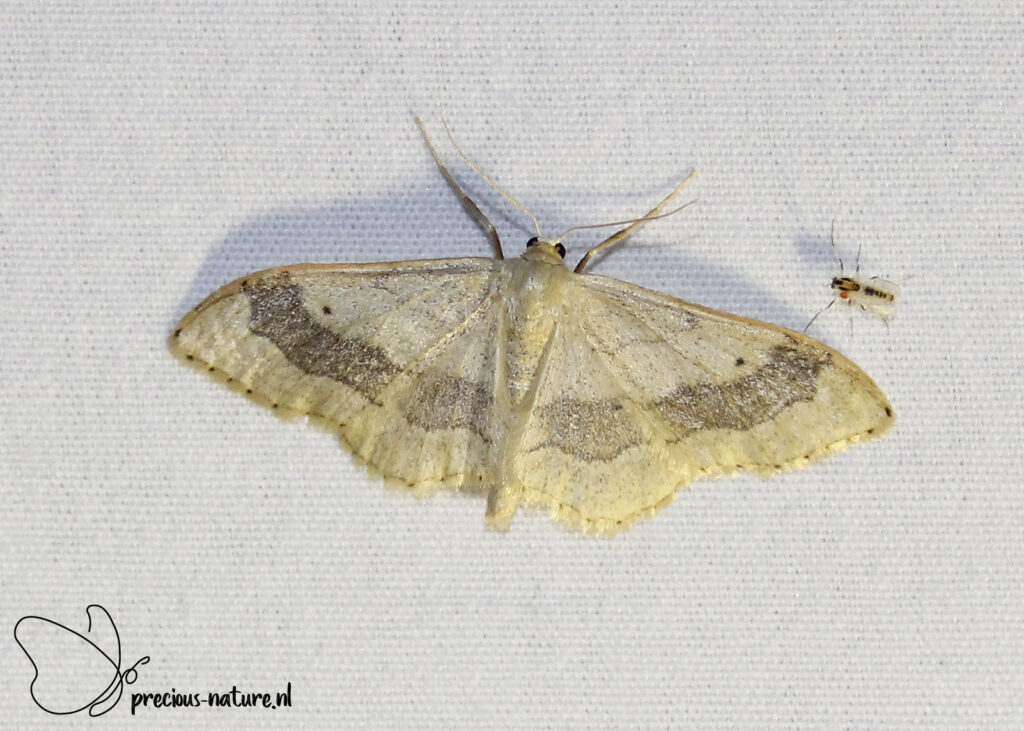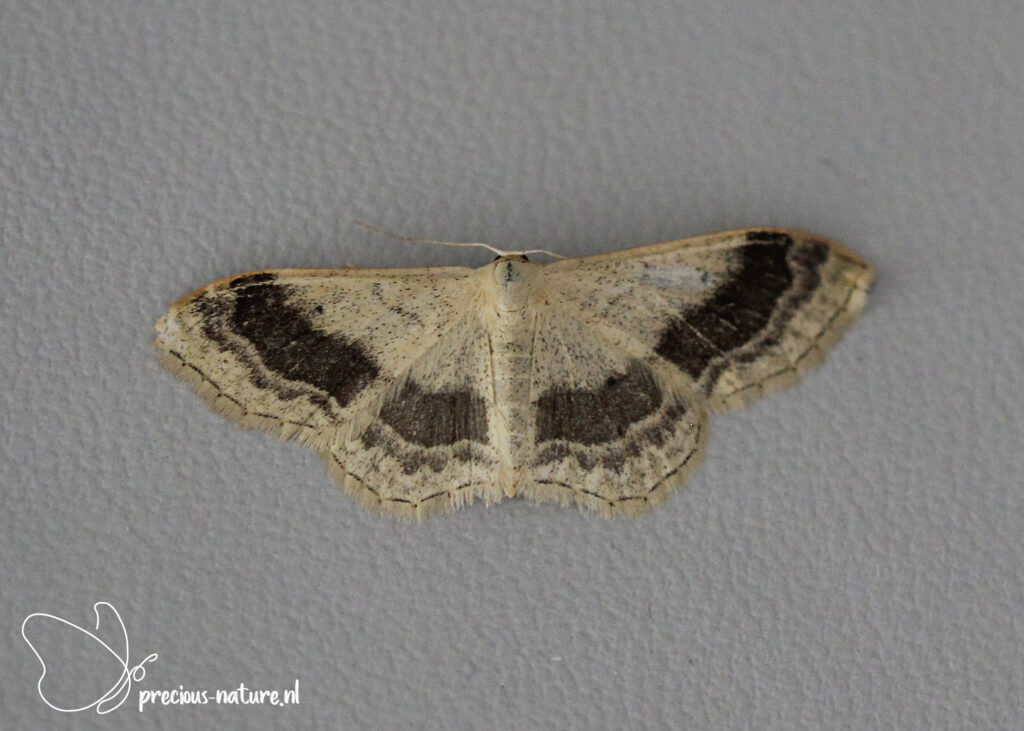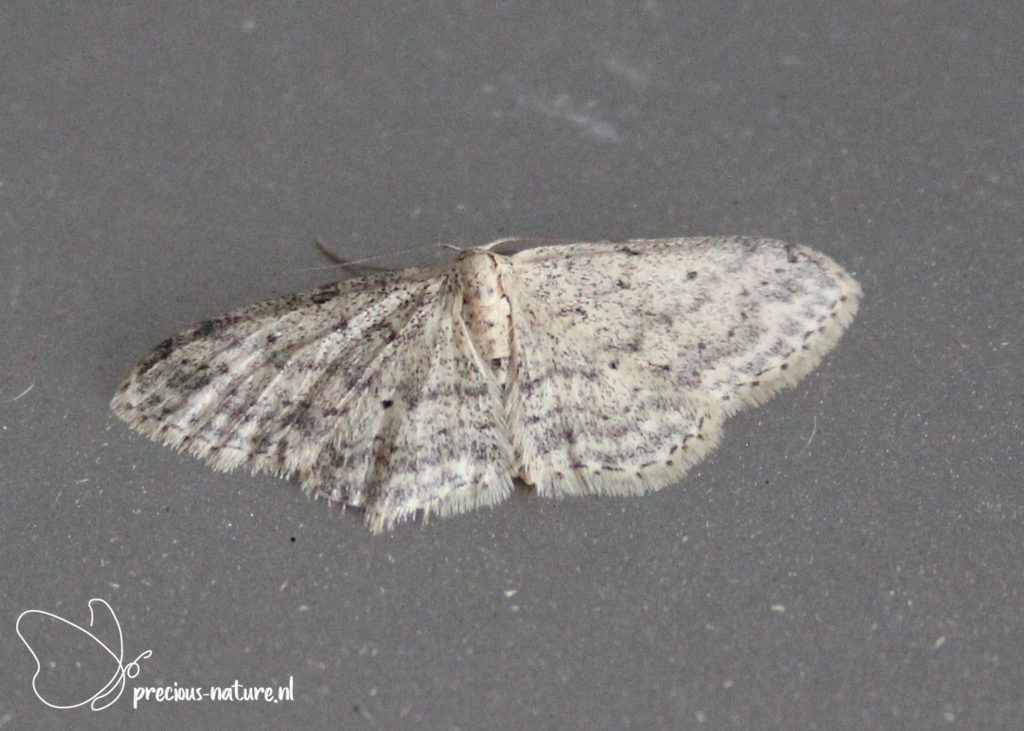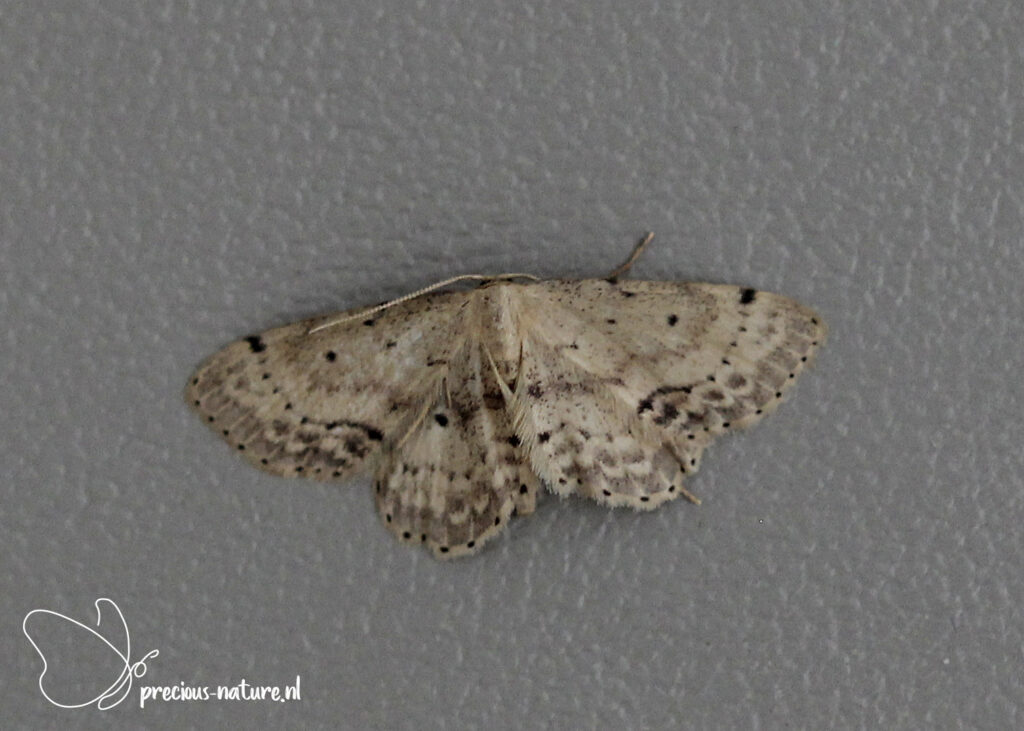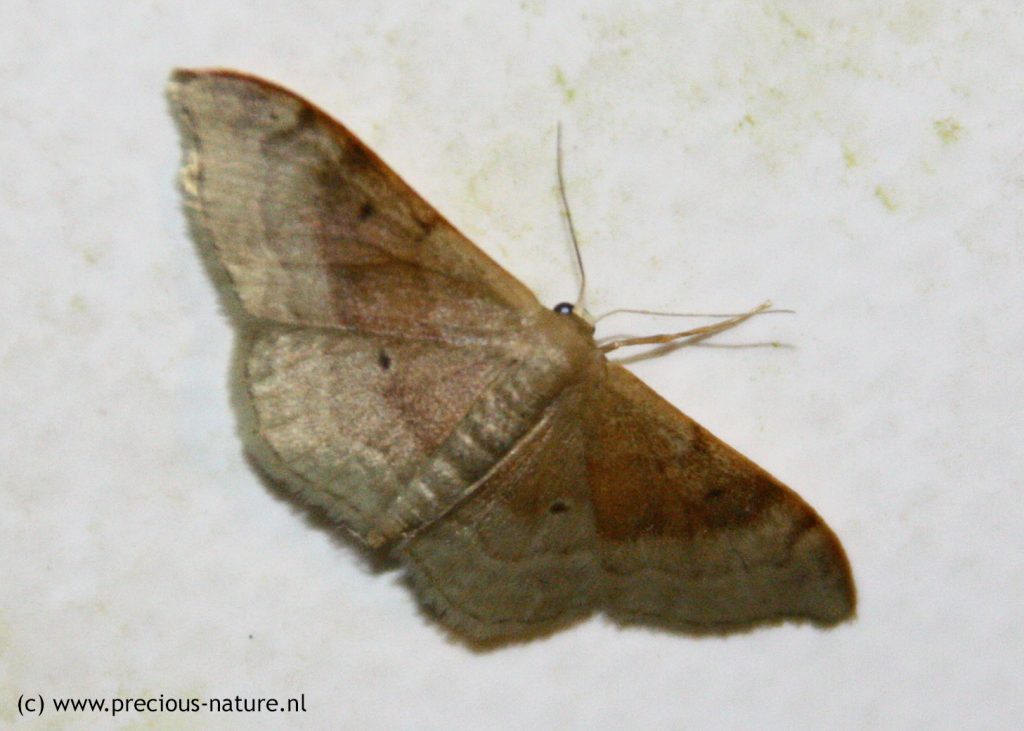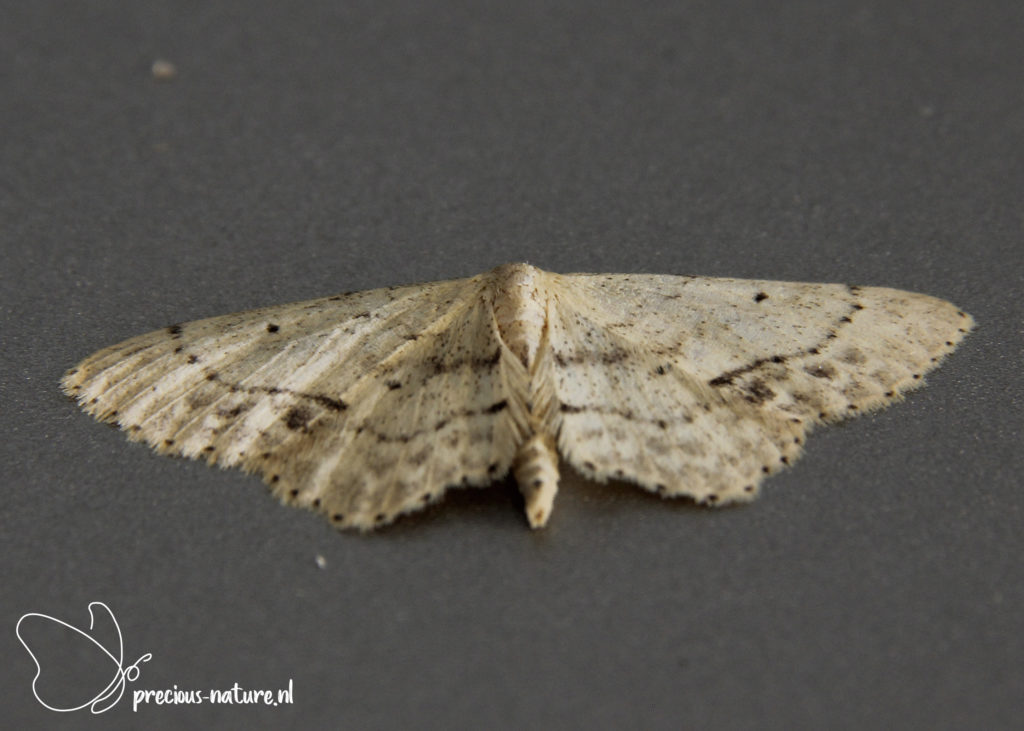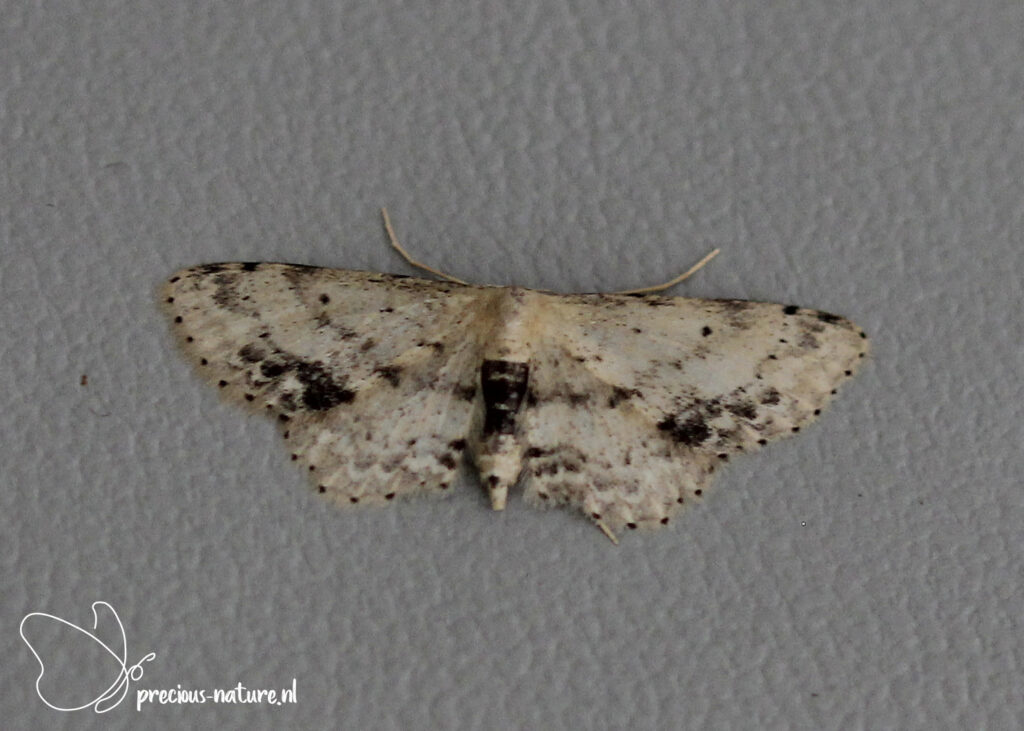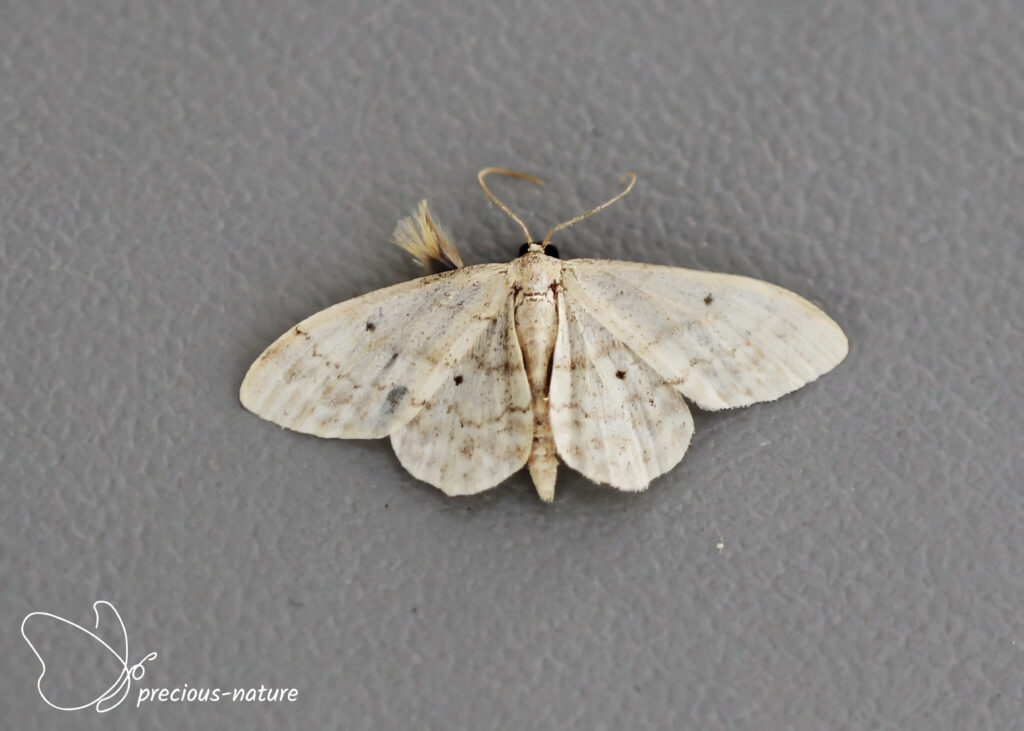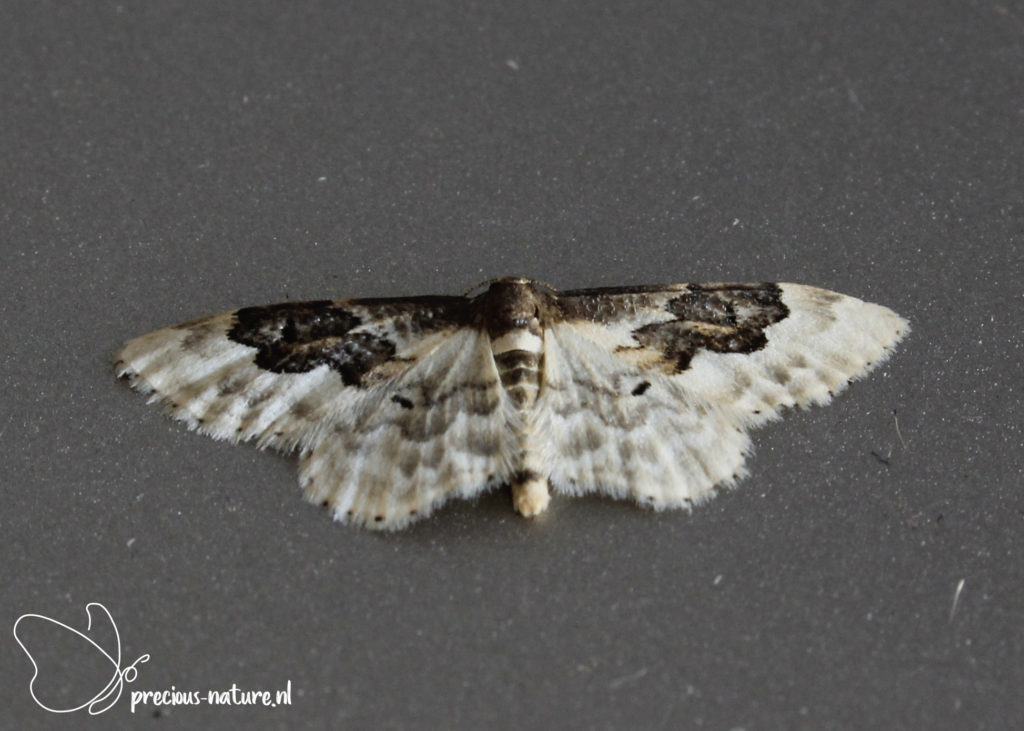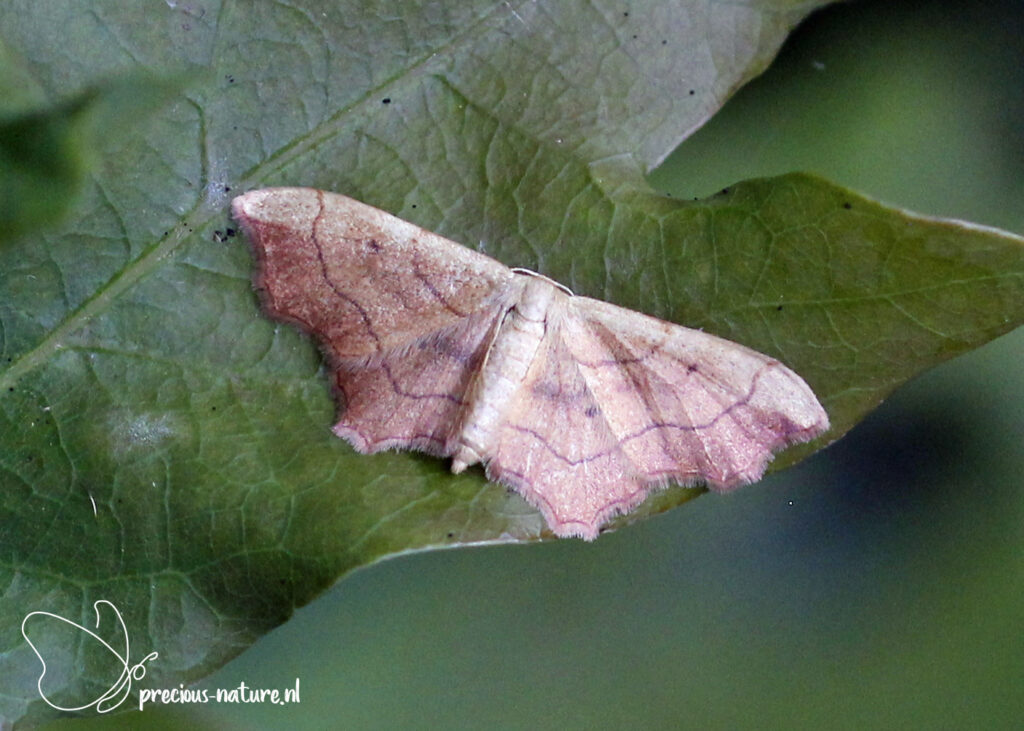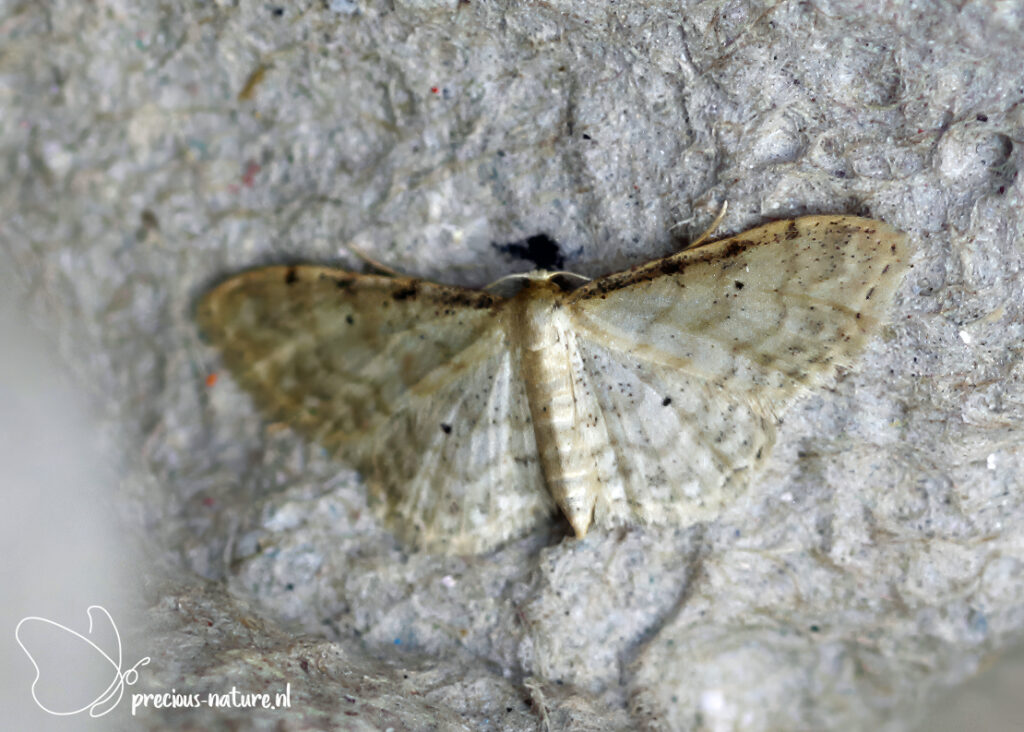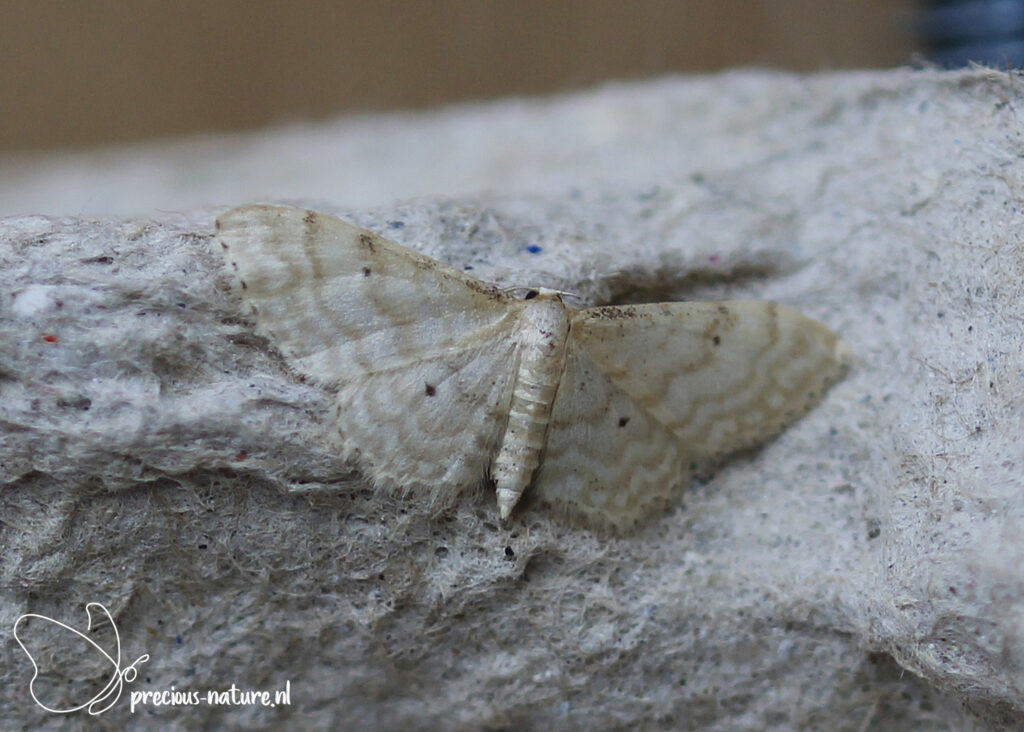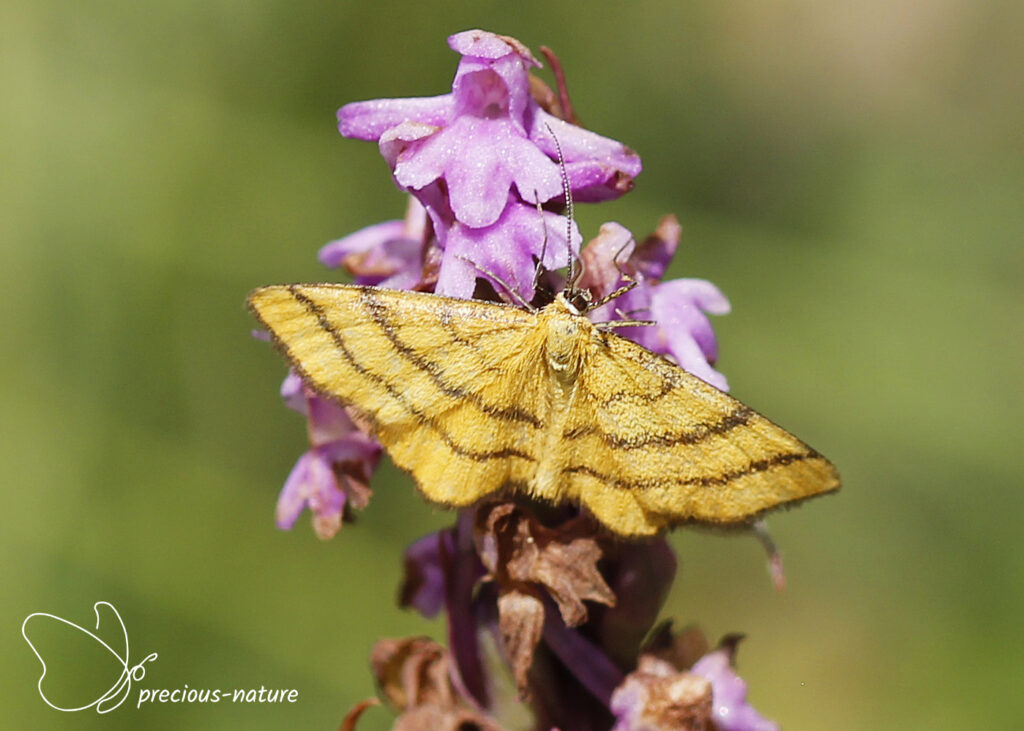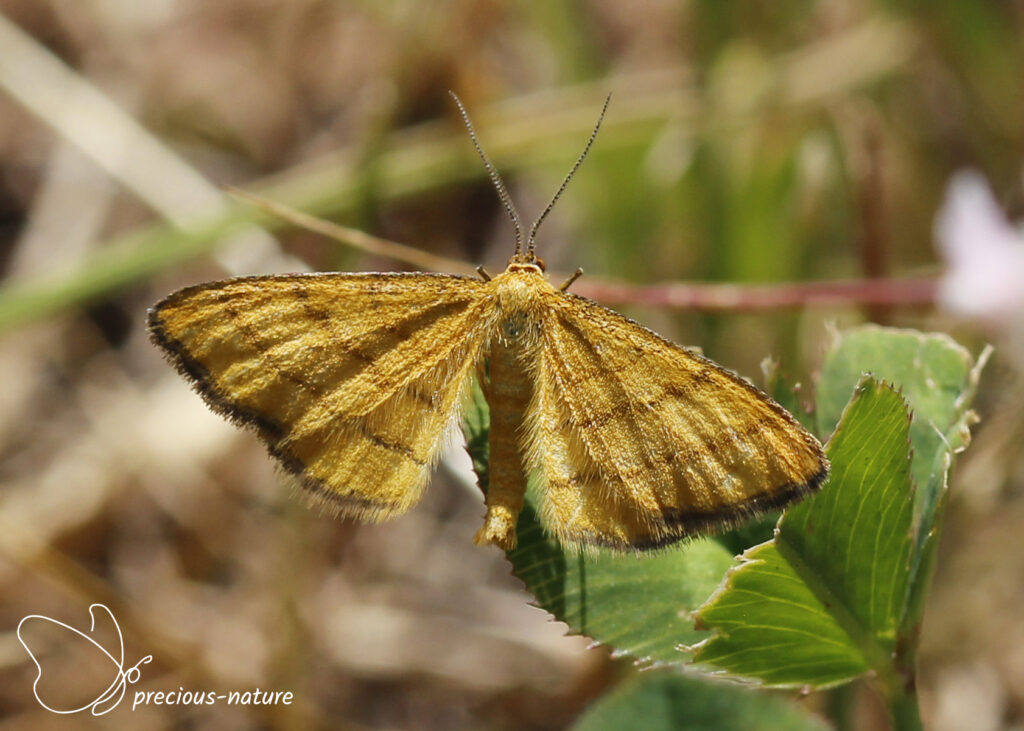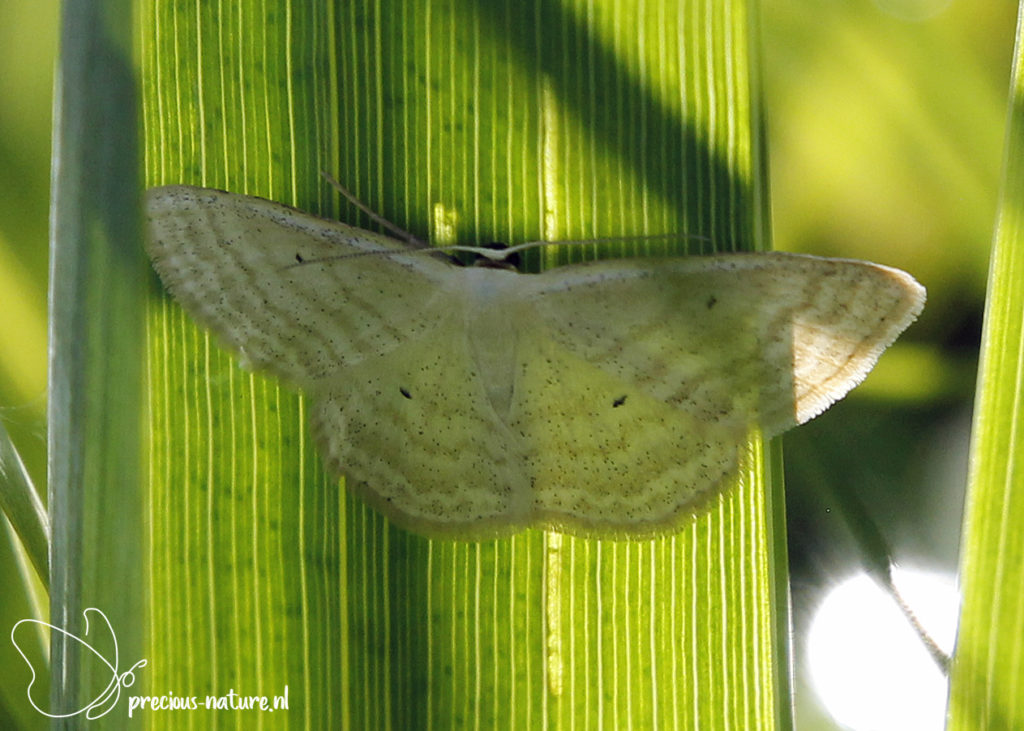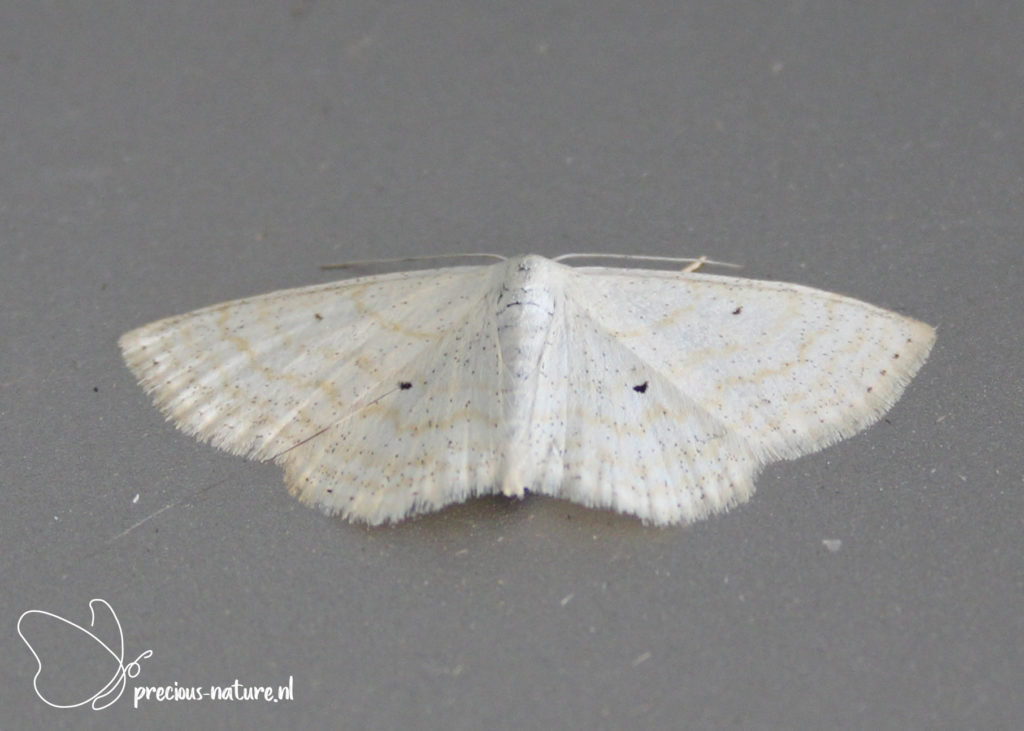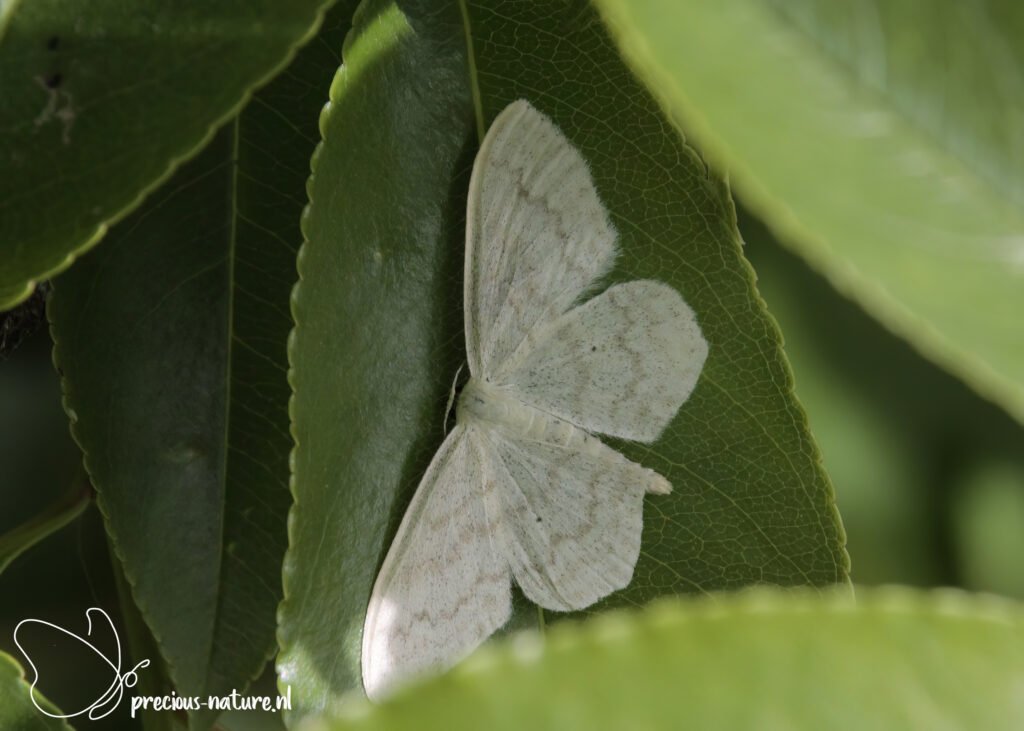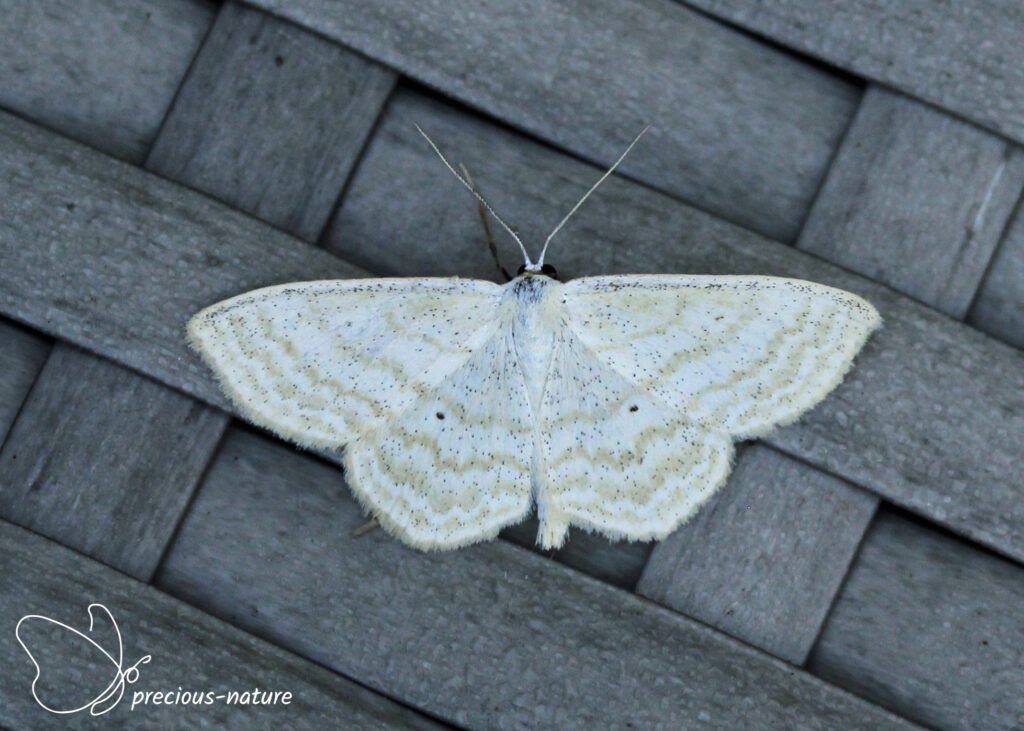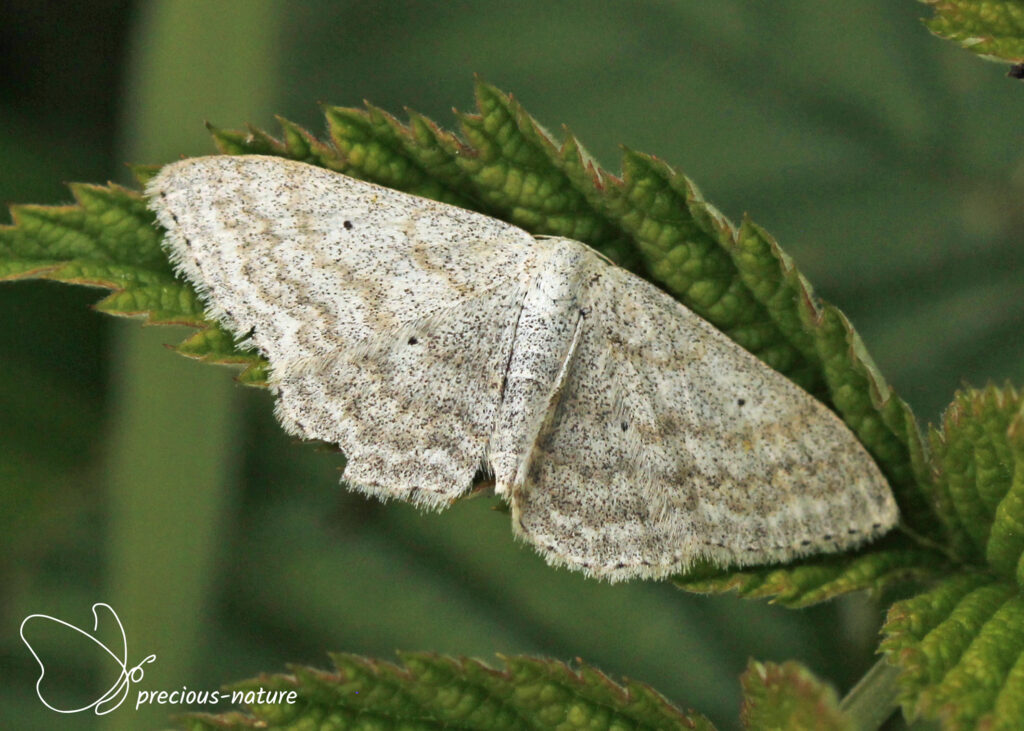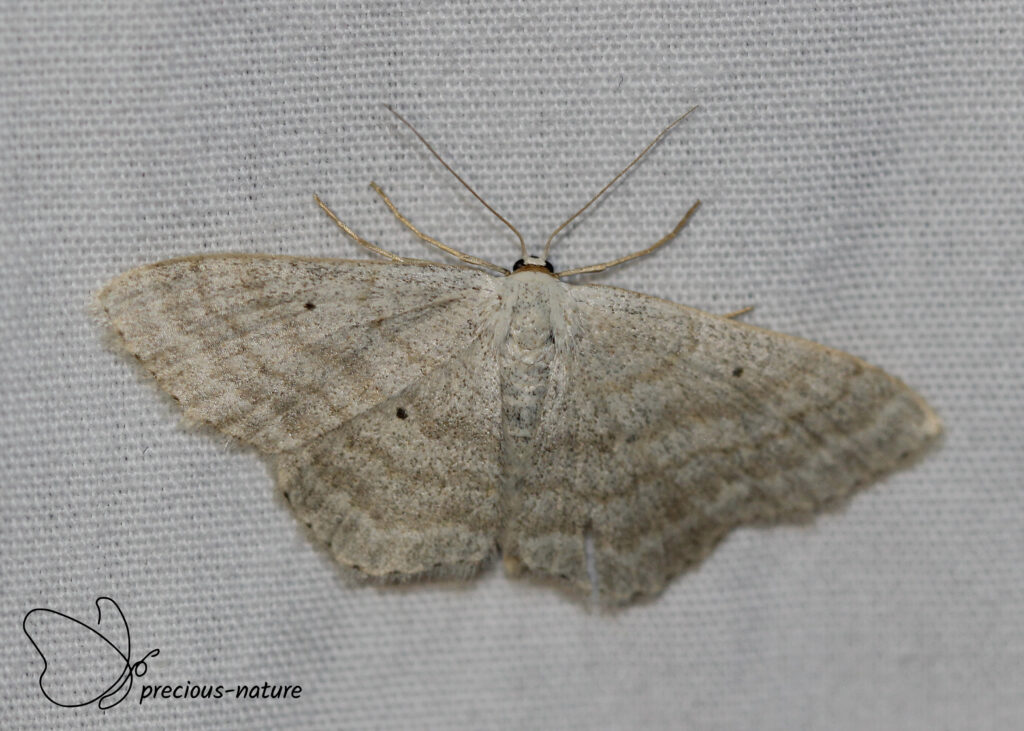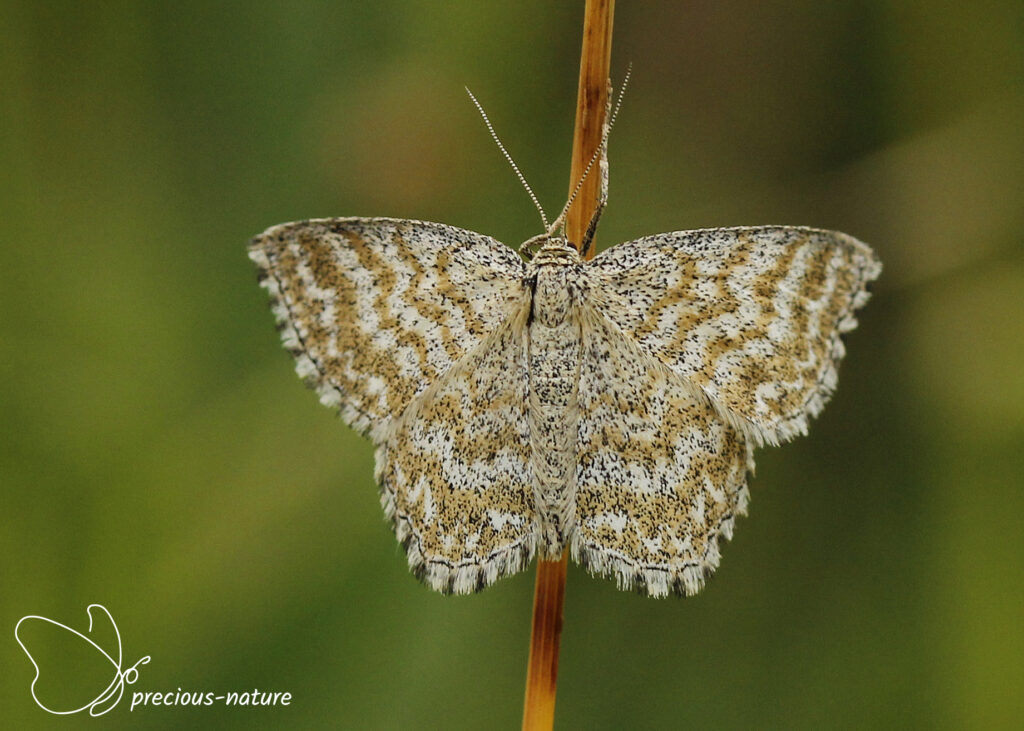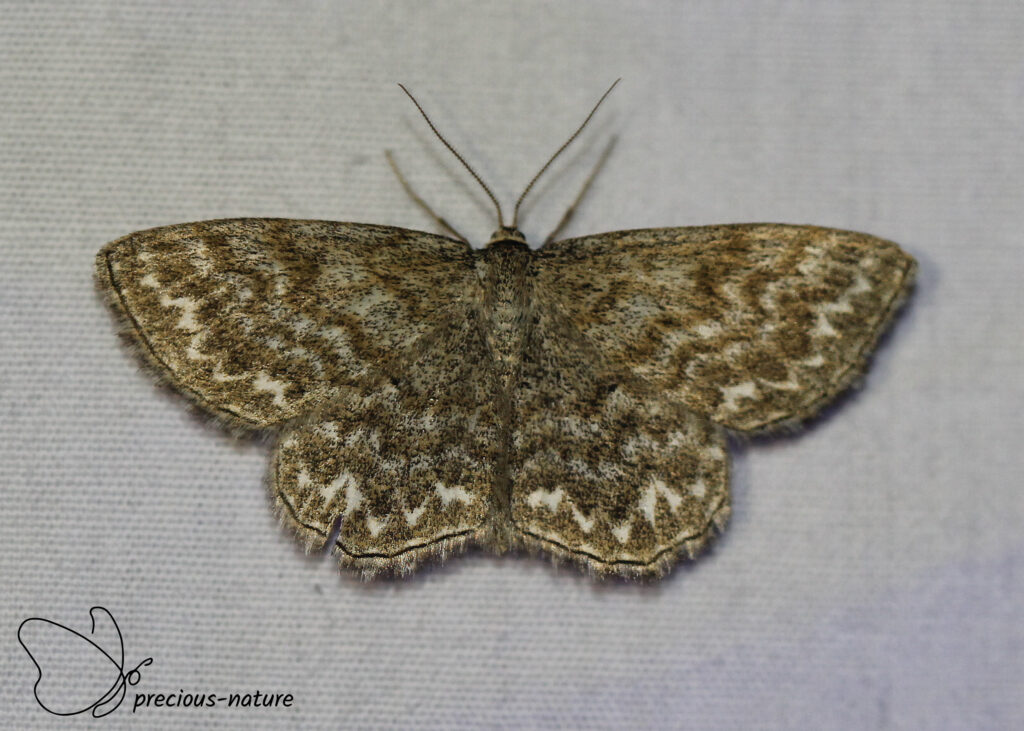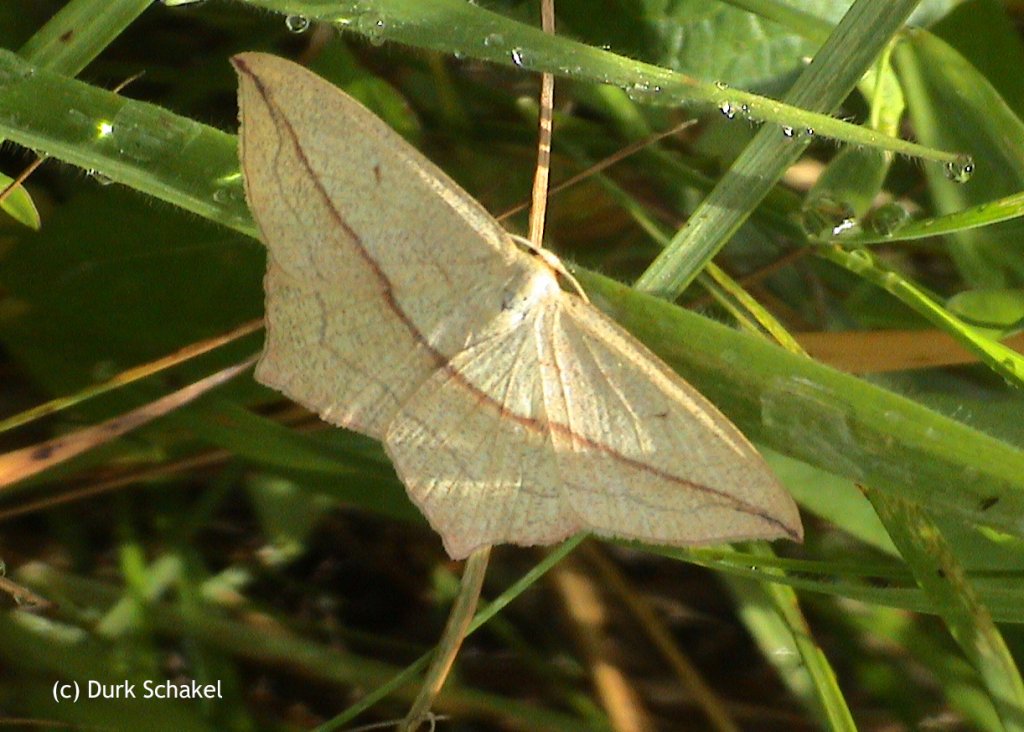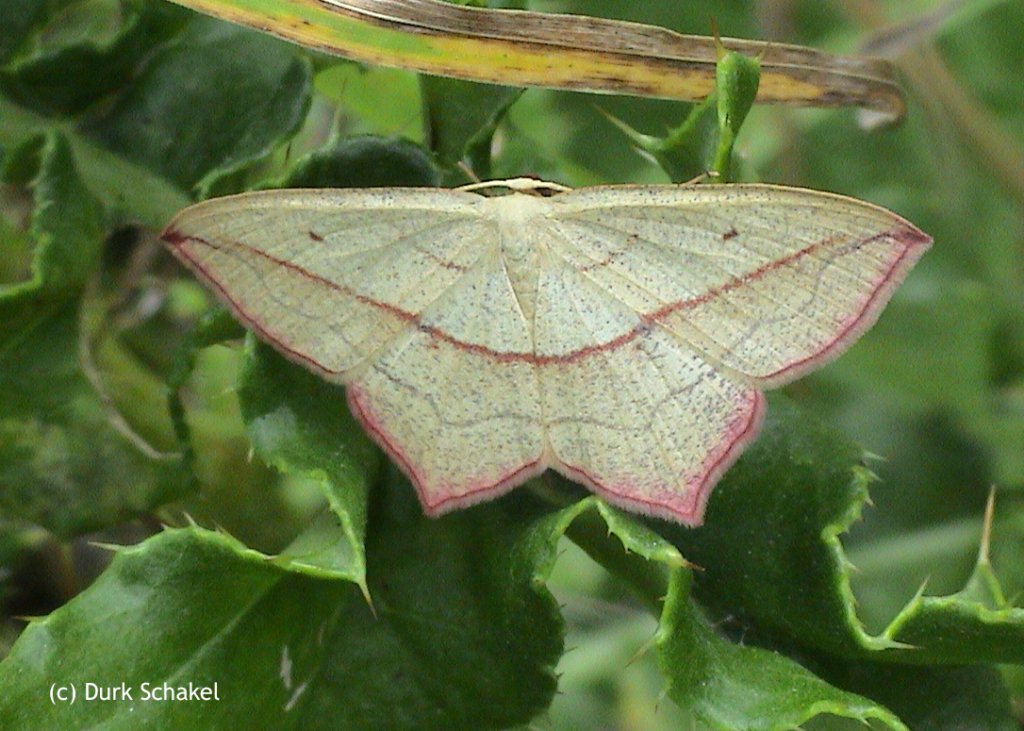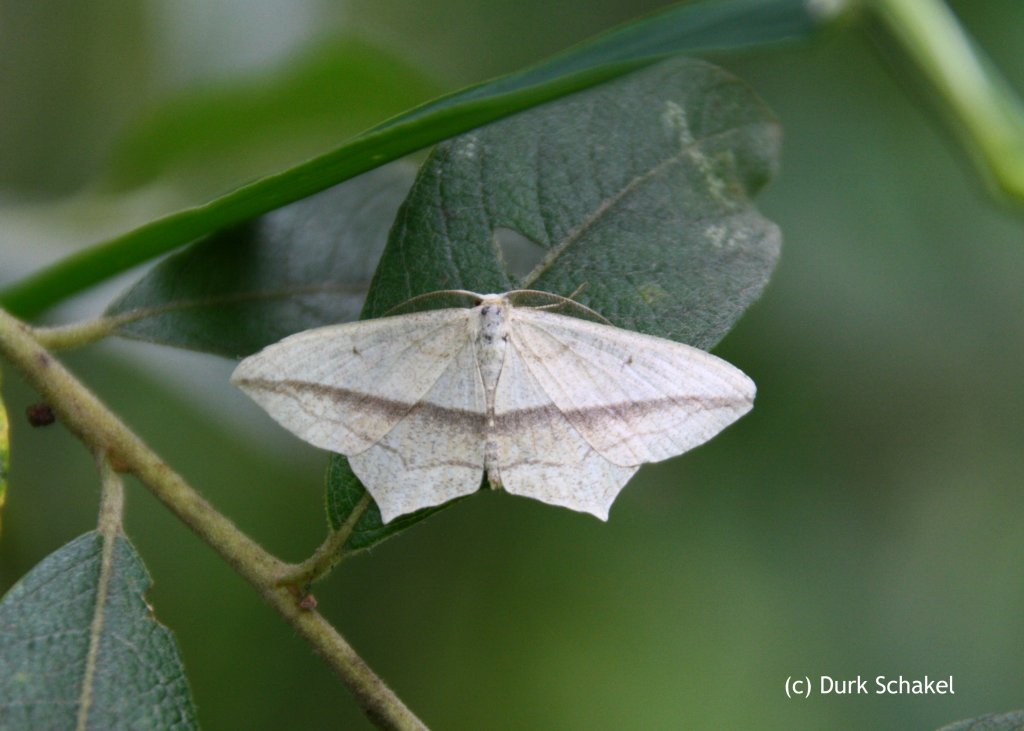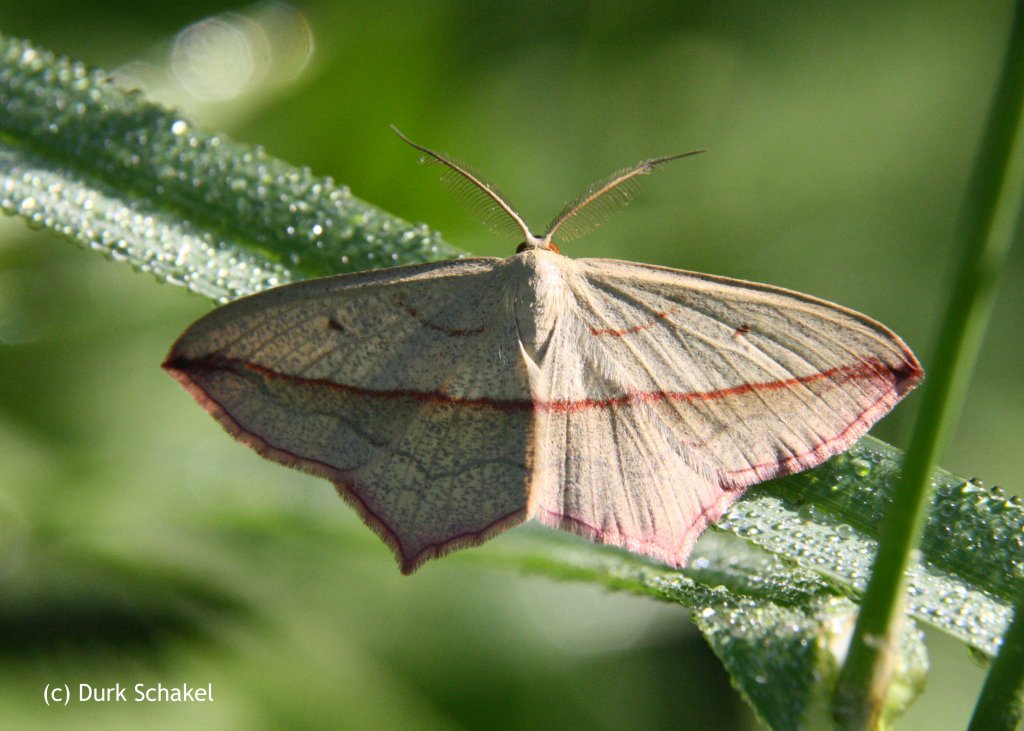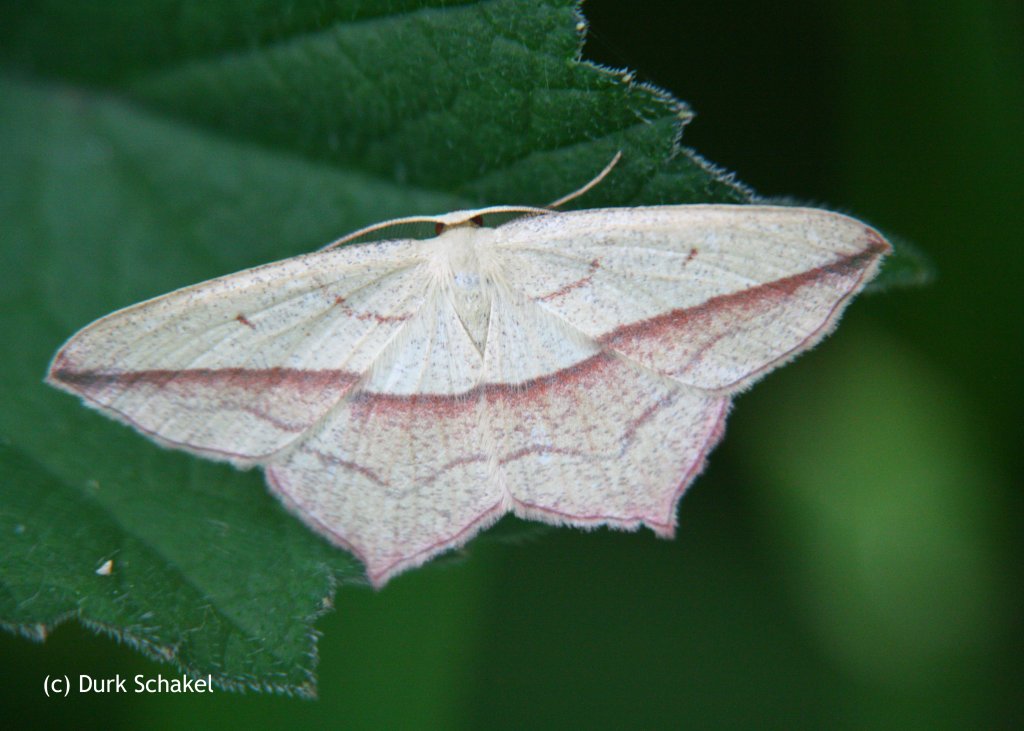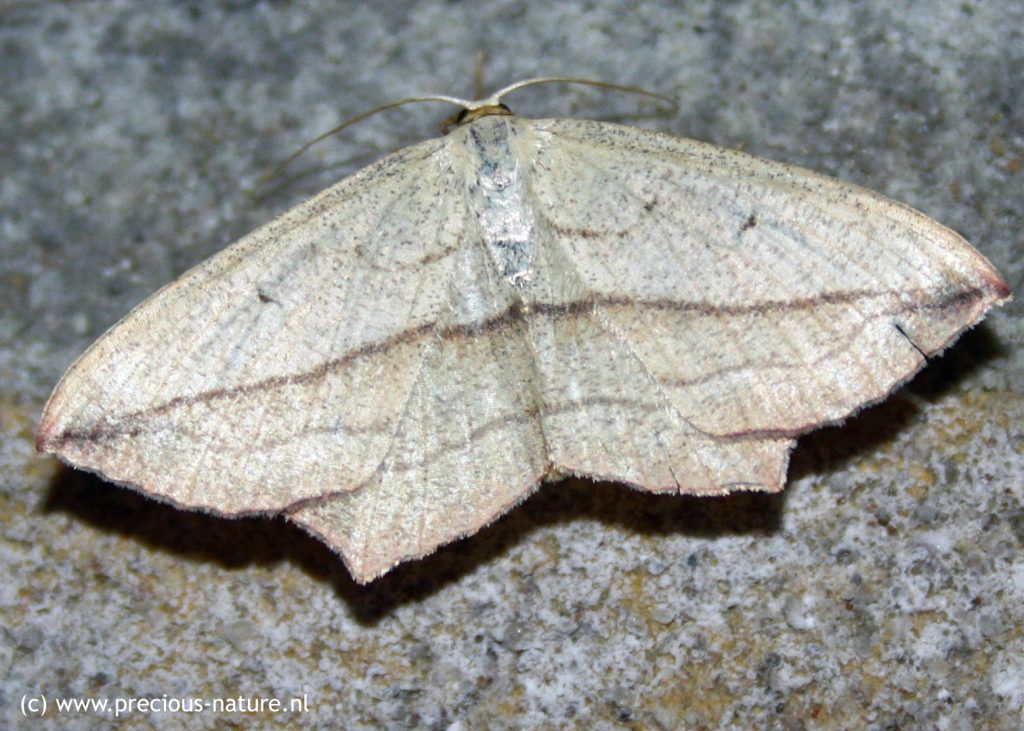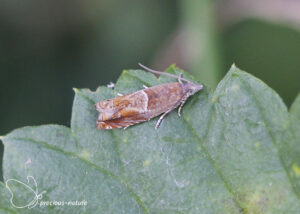Sterrhines (Sterrhinae) are a subfamily of the Geometer Moths (Geometridae) with 2,800 described species.
Genus: Cyclophora
Maiden’s Blush – 2019 (NL)
(NCBI-index: 310442)
A moth with no eyelets on the front or rear wings is the Maiden’s Blush (Cyclophora punctaria). The base colour is light brownish-yellow, with the hindwing slightly lighter in colour. Some specimens, especially the summer generation, have a large reddish blush on the forewing. Square reddish-brown spots can sometimes be seen near the tornus. A reddish central transverse line runs across the wings, sloping to the costa at an angle of less than 90 °. The post-median line of dots is wavy and deviates near the inner edge of the wing towards the tornus. Sometimes, the wings are speckled black. The flight period is from April to the end of August in two generations, and the wingspan is 26-32 mm. Host plant: Oak, Birch. Dutch name: Gestippelde oogspanner. Frisian name: –
Flying period:

Genus: Cyclophora
Birch Mocha – 2021 (NL)
(NCBI-index: 505405)
Walking around in another nature reserve often results in different species. This also applies to the Birch Mocha (Cyclophora albipunctata), which is mainly found in areas with sandy soils. The wings are solid grey-white, with the inner and outer transverse lines consisting of small black spots. The central transverse line is often grey-black or reddish, which is less visible in very light specimens. A clear eye mark can be seen on both the forewing and hindwing. The Birch Mocha is distinguished from the Dingy Mocha (Cyclophora pendularia) by the lack of the sickle-shaped apex of the forewing. The wingspan is 20-25 mm, and the flight period is from early May to late August for two generations. Host plant: Birch. Dutch name: Berkenoogspanner. Frisian name: –
Flying period:

Genus: Idaea
Riband Wave – 2009 (NL)
(NCBI-index: 104447)
The Riband Wave (Idaea aversata) has two different variations. That difference is situated in the median band. On the light yellow-brown wings, there are many dark grey scales and three, two of which are visible, transverse lines. In some specimens, the band between the two outer transverse lines is dark-coloured, so a visible band runs over the wings. There is a clear dot on both the fore- and hindwings. The Riband Wave flies in two generations from June to September, and the wingspan is 28-32 mm. Host plant: Bedstraws, Wood Avens, Dandelions, Dock. Dutch name: Grijze stipspanner. Frisian name: Grize stipspanner.
Flying period:

Genus: Idaea
Small Dusty Wave – 2015 (NL)
(NCBI-index: 190354)
The Small Dusty Wave (Idaea seriata) has a clear central spot on all wings. The ante-median and post-median lines are thin but always clearly visible. The fringe line along the termen consists of alternating bows and dots; in some specimens, a yellowish colour can be seen in the fringes. The wings are further darkly speckled. He flies in two generations from May to October, and the wingspan is 19-21 mm. Host plant: Herbaceous plants, including Ivy. Dutch name: Paardenbloemspanner. Frisian name: Hynsteblomspanner.
Flying period:

Genus: Idaea
Portland Ribbon Wave – 2018 (FR)
(NCBI-index: 190350)
I couldn’t find a Dutch name for the Portland Ribbon Wave (Idaea degeneraria). There were English and German names for this moth on the internet, but no Dutch name. Possibly because this moth is hardly seen in the Netherlands. Therefore, I derived a Dutch name from a foreign language. This reasonably large moth has two colours: brown and pale white. The outer part of the forewing and the hindwing are pale white, and the inner half is brown; the part closest to the wing base is lighter brown. A straightforward black dot can be seen on both the fore- and hindwings. The flight period is from April to September in two generations, and the wingspan is 26-31 mm. Host plant: Dandelion, Knotgrass. Dutch name: Tweekleurige bandspanner. Frisian name: –
Flying period:

Genus: Idaea
Single-dotted Wave – 2019 (NL)
(NCBI-index: 572776)
A pleasant surprise in the light trap after a cloudy summer night was the Single-dotted Wave (Idaea dimidiata). The base colour of the wing is straw-coloured, whitish to greyish-light brown. The black dots in the middle are always clearly visible. The median transverse lines are usually thin and faintly visible except for the dots on the veins. The post-median line is typically visible with the characteristic black dot at the costa. The fringe line is provided with a row of black dots; at the tornus, there are striking, closely adjacent black spots. The wingspan is 13-18 mm. The flight period is from June to August; sometimes, a second generation is in September. Host plant: Cow Parsley, Burnet Saxifrage. Dutch name: Vlekstipspanner. Frisian name: Flekstipspanner.
Flying period:

Genus: Idaea
Small Fan-footed Wave – 2020 (NL)
(NCBI-index: 104448)
The Small Fan-footed Wave (Idaea biselata) with cream-coloured and dark-speckled wings has several similar species. A central black dot can be seen on both the fore- and hindwings—the median line on the forewing curves around this dot in a slight arc. In the Small Dusty Wave (Idaea seriata), the median line runs close to the central spot. Characteristic is the jagged post-median line with a grey-brown zoom field outside, interrupted by an irregular light wave line. With the Single-dotted Wave (Idaea dimidiata), the marginal area only has some dark spots. In addition, the sharply deflected apex of the Small Fan-footed Wave is striking. The wingspan is 15-20 mm, and the flight period runs from May to the end of September for one or sometimes two generations. Host plant: Various herbaceous plants and fallen leaves. Dutch name: Schildstipspanner. Frisian name: Skyldstipspanner.
Flying period:

Genus: Idaea
Least Carpet – 2021 (NL)
(NCBI-index: 1.101010)
Geometer moths are often challenging to identify, but that is not a problem for the Least Carpet (Idaea rusticata). The shiny white forewing has a dark brown median band and base. The hindwing has dark serrated spots that form transverse lines. A black centre dot can be seen on both the fore and hind wings. At the forewing, it is less noticeable because of the dark brown median band. In addition to the dark brown head and the dark brown transverse stripes on the abdomen, the white segment immediately after the head is visible. The wingspan is 19-21 mm, and the flight period runs from June to October for two generations. Host plant: withered and dead leaves of various plants, vines, and Ivy. Dutch name: Schaduwstipspanner. Frisian name: –
Flying period:

Genus: Idaea
Small Scalop – 2023 (NL)
(NCBI-index: 986993)
Most geometer moths fly around at night, and you can only see them when they are attracted to light and land on your stretched white sheet. Sometimes, you are lucky enough to see specimens sitting on a leaf in the early evening, preparing for the adventurous night. The first Small Scalop (Idaea emarginata) I saw was an example of the latter. It can be easily recognised by the coarsely scalloped trailing edge of the wings, the sharp, beautifully wavy central transverse lines, the clear wing veins, and the clear centre spot on both the fore and hind wings. The male is sandy to light brown, and the smaller female is more orange-tinged and darker. The female also has a clear, wide dark zone on the fore and hind wings, which is less visible in males. The fringes along both wings are strikingly checkered. This moth likes to fly around in one of my favourite areas, which has marshy meadows and woodland. He flies in one generation from June until the end of August, and his wingspan is 22-25 mm. Host plant: Bindweed, Aspen, Willow, Birch. Dutch name: Geblokte stipspanner. Frisian name: –
Flying period:

Genus: Idaea
Dwarf Cream Wave – 2023 (BE)
(NCBI-index: 934872)
The wings of the Dwarf Cream Wave (Idaea fuscovenosa) are cream-coloured and white, and there is a clear, small centre spot on the fore and hind wings. The leading edge of the forewings is covered with brown dots from the root of the wing up to approximately halfway, forming a faint band. The various brown, wavy transverse lines are thickened at the leading edge. The fringe line of the wings consists of fine dark stripes. Short lines can sometimes be seen at right angles to those lines. You often need a magnifying glass for that. The fringe has a light, yellowish to golden hue. The flight period spans one generation, from early June to early August, and the wingspan ranges from 19 to 22 mm. Host plant: mosses and fallen leaves. Dutch name: Dwergstipspanner. Frisian name: –
Flying period:
![]()
Genus: Idaea
Golden-yellow Wave – 2024 (CH)
(NCBI-index: 986991)
An official Dutch name has not been found for the Golden-yellow Wave (Idaea aureolaria) seen in Switzerland. Three dark brown crossbands on the forewing and two on the hindwing are present. In males, these are often more clearly present than in females. Furthermore, the rear edge of the forewing and hindwing is strikingly dark brown in the male, while this is hardly visible in the female. The difference is obvious in the hindwing. The forewing’s dark spot on the middle crossband’s inside is not always clearly visible. The flight period is one generation from June to July, and the wingspan is 14-20 mm. Host plant: Crownfetch. Dutch name: Goudgele dwergstipspanner. Frisian name: –
Flying period:

Genus: Scopula
Lesser Cream Wave – 2017 (NL)
(NCBI-index: 987004)
The Lesser Cream Wave (Scopula immutata), a relatively small member of the Sterrhines, has wings with thinly scattered black scales. The male’s wings are creamy-white, and the female’s wings are white. The light yellow transverse lines are visible and undulated. There is always a visible black dot on the hindwing. The fringe line is darker, and often, there are faint spots here. He flies in one generation from June to September, and the wingspan is 24-27 mm. Host plant: Meadowsweet. Dutch name: Bosspanner. Frisian name: Boskspanner.
Flying period:

Genus: Scopula
Cream Wave – 2024 (CH)
(NCBI-index: 987005)
The Cream Wave (Scopula incanata) does not occur in the Netherlands. It mainly occurs in mountainous to subalpine grasslands and meadows on limestone and silicate (juniper heath, quarries, wide forest edges, rocky slopes, etc.). The creamy white wings are intensively covered with tiny black speckles. Four wavy, dark transverse lines can be seen on both wings. A wide, dark-coloured band runs along the rear edge, and the outer edge consists of a thin, brown-black interrupted line. A black spot can be seen on both the forewing and the hindwing. The flight period is from May to September in two generations, and the wingspan is 22-28 mm. Host plant: Lotus, Horse-shoe Clover, Pimpernel. Dutch name: Bergstipspanner. Frisian name: –
Flying period:

Genus: Scopula
Lewes Wave – 2024 (CH)
(NCBI-index: 104444)
The brown, grey, white and blackish scales make the Lewes Wave (Scopula immorata) a beautiful and striking moth. The pattern is very variable, with grey and sometimes brown predominating. In many specimens, the pattern consists of a succession of diffuse dark bands on a lighter greyish background. In some specimens, however, clear dark bands can be distinguished in the middle field that can be recognised as the central transverse lines. An often interrupted whitish-wavy line can be seen in all forms in the margin. The fringe is blocked. The flight period is one generation, sometimes a second, from the end of June to mid-August, and the wingspan is 24-28 mm. Host plant: Common Yarrow, Common Mugwort, Heather, Wild Marjoram, Broad-leaved Thyme. Dutch name: Donkere prachtstipspanner. Frisian name: –
Flying period:

Genus: Timandra
Blood-vein – 2008 (FR)
(NCBI-index: 190366)
The Blood-vein (Timandra comae) is easily recognised by the pink-red or sometimes a brownish-red line that runs from the apex over the cream-coloured forewing to the dorsum. The hindwing dorsum also has a thin rose-red line or a fuzzy strip, but some specimens lack that colour. There is still a thin grey line under the wider coloured median band. Furthermore, the Blood-vein has a distinct black point near the costa. He flies in usually three generations from May to October, and the wingspan is 30-46 mm. Host plant: Common Sorrel, Knotgrass. Dutch name: Lieveling. Frisian name: Readrânespanner.
Flying period:


